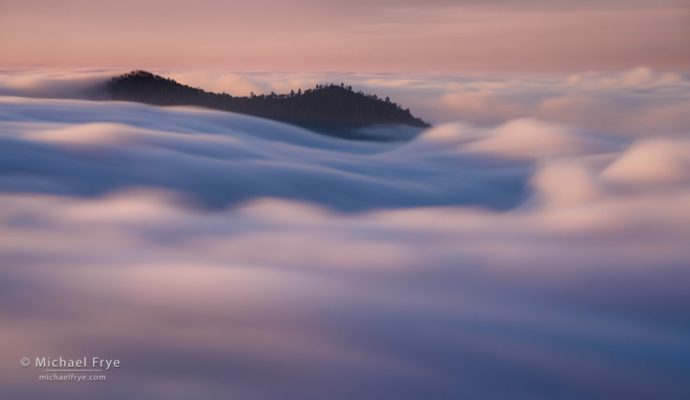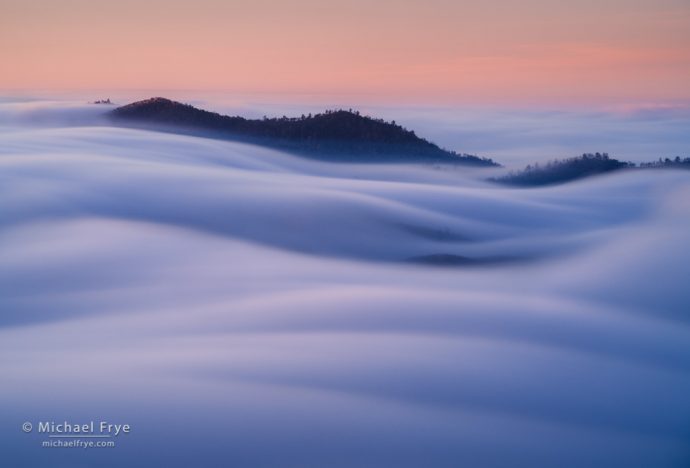
Cascading fog, Sierra Nevada foothills, California. 111mm, 15 seconds at f/11, ISO 200, 4-stop ND filter.
We’re in the midst of another dry spell here. After some modest rain in December and early January, the storm track has shifted north, with no precipitation in sight for at least the next two weeks.
But we got enough rain to add some moisture to the ground and the lower atmosphere, which triggered the typical winter fog pattern in California’s Central Valley. Fog down there has been a daily occurrence, and that pattern is expected to continue for awhile.
Sometimes that low-level fog lifts a bit, into what meteorologists call a stratus deck. From the ground in the Central Valley it looks like a low overcast, but if you gain a little elevation by driving into the mountains you’ll enter the clouds and become enveloped in fog. And if you continue climbing you’ll rise above the fog.
Since there are no storms on the horizon, the most interesting weather in the area is that fog. Claudia and I have made some trips down to the Central Valley to photograph birds, but I’ve also looked for times when the fog might lift into a stratus deck, and push up into the Sierra foothills. Yesterday morning looked like one of those times, with weather models showing low clouds moving farther east into the foothills than usual. That could give me an opportunity to photograph trees in the fog, but even better, the mountainous terrain might allow me to find a view over the clouds from above.
So we rose early yesterday morning and drove out to a spot we’d scouted before. I hoped this spot would be just above the fog layer – and it was, but just barely. And then the fog rose further, so we became enveloped in it.
We decided to drive to another, higher spot nearby that we hoped would now be at the right height to give us a view over the clouds. As we drove higher we emerged from the fog and found an ocean of clouds laid out below us, just as the sunrise was coloring the eastern horizon.
Seen from above, the clouds were flowing rapidly from south to north. I saw some hills to the southwest poking out of the fog that could serve as visual focal points, and right below those hills the fog was dipping into beautiful waves.

Waves of fog, sunrise, Sierra Nevada foothills, California. 100mm, 30 seconds at f/16, ISO 100, 7-stop ND filter.
I knew from previous experience that long exposures would show off the motion and patterns of those waves better than short ones. So I put on neutral-density filters in order to push my shutter speeds up to 15, 20, or even 30 seconds. I spent the next hour or so photographing those waves, first before the sun rose, then as sunlight started to catch the tops of the clouds.
Making photographs like these was a lot of fun for me, since I don’t get to do it often. And there’s always something magical about being above the clouds. You feel as if you’re in a different world, floating above the petty concerns of the world below. That was an especially welcome feeling during these turbulent and troubled times.
— Michael Frye
Related Posts: Above the Fog; Oceans of Fog: Part One; Oceans of Fog: Part Two
Michael Frye is a professional photographer specializing in landscapes and nature. He is the author or principal photographer of The Photographer’s Guide to Yosemite, Yosemite Meditations, Yosemite Meditations for Women, Yosemite Meditations for Adventurers, and Digital Landscape Photography: In the Footsteps of Ansel Adams and the Great Masters. He has also written three eBooks: Light & Land: Landscapes in the Digital Darkroom, Exposure for Outdoor Photography, and Landscapes in Lightroom: The Essential Step-by-Step Guide. Michael has written numerous magazine articles on the art and technique of photography, and his images have been published in over thirty countries around the world. Michael has lived either in or near Yosemite National Park since 1983, currently residing just outside the park in Mariposa, California.









I REALLY like this shot. Many times I have been on ridge tops like that watching the fog rush in at my feet at a rapid pace…and for some reason, I have never once thought to take a long exposure.
One of my favorites!
Thanks very much Jody! Hope you get a chance to try that long exposure.
So much about that had to be fun! The drive to find that magical spot. Seeing the light separate into different shades. Watching the flow of the mist as if it’s in a creek bed. Very nice composition.
It was a lot of fun – thanks!
WOW, Michael, this is stunning!! I live in the central valley but haven’t found a place to shoot these the way you captured. Do you have any tips on what to look for or where to go?
Thanks Josh! As for tips… it’s complicated. The easy and obvious part of the answer is that you have to get into the hills on either side of the valley to get above the fog. But exactly where and when depends on the fog. Sometimes the fog inhabits only the lowest parts of the valley, where there are no hills, and no way to get above the fog without a drone. Sometimes the fog layer is thicker, or lifts into a stratus deck, and when that happens it can extend up into the hills, where there’s some topography, and a chance to find a perch near the fog, but above it. Predicting when that will happen is challenging; I look at computer weather models to give me hints, and then might get up early to consult satellite images, weather stations, and webcams to see whether the fog has moved into the foothills. From there I’ll take a guess about what elevation the top of the fog has reached, and try to think of a suitable spot that’s just above that level. That task is further complicated by the lack of public land in the foothills, so you’re usually restricted to public roads. It helps to do some advance scouting to look for publicly-accessible roads with views.
This is really cool, Michael! Beautiful color. This is giving me ideas for when fog season rolls in.
Michael,
First off, thank you so much for taking the time to write all that. I really value your insight, time and how much you give to the photography community. It goes without saying I think you’re one of the most talented and amazing landscape photographers I’ve seen….so hearing from you personally means a lot.
Everything you said makes perfect sense. It’s been challenging to scout when there isn’t fog and I don’t often get out enough when there is to find great spots. I’m a bit South of you in Fresno…but I’m curious if there’s something you look for when scouting—like certain trees or a mountaintop—or if finding a place where fog is likely to move (in a gap) is more your focus when scouting for something like this. There are *so* many things to keep mindful of, not the least of which is the sun. Yikes.
You’re welcome Josh, and thanks for the kind words. I don’t have anything specific in mind when scouting other than finding elevated, publicly-accessible locations where I could get above the fog if the fog is at the right elevation. It’s hard enough to find those.
Gotit. Thank you!